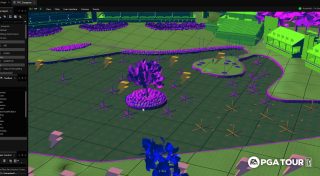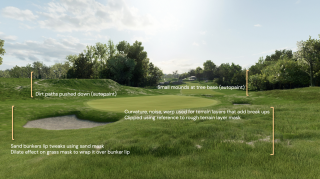How Procedural Tools are Reshaping Terrain Workflows

Five years ago, when Frostbite first started work on its procedural terrain tools, terrain creation was still largely a manual process. Materials required extensive hand-painting and import/export cycles were interruptive and expensive, making even minor revisions slow. Today, feedback is immediate. Frostbite Terrain Tools — now in use across seven EA titles — empower creators with live feedback, non-destructive workflows, and powerful procedural generation options.
EA SPORTS™ PGA Tour™ is one of the most recent EA games to take advantage of Frostbite’s Terrain Procedural Tools, using them to bring 28 real-world courses to life. The team started by collecting data — using LiDAR (3D laser)-equipped drones, helicopters, and planes to map out the terrain of each course. High-density point-and-cloud vectors of fairways, roughs, and greens were then processed through procedural software to extract heightfield maps and masks, which were in turn imported into the Frostbite Editor.

Terrain Procedural Tools in Action
One of the biggest benefits of Frostbite’s Terrain Procedural Tools is live feedback. As artists place and move assets like stones or trees, they can see the terrain adjust around them in real time. The same is true for terrain shaping — using heightfield data from raster layers (called “overlays” in the Frostbite Editor), artists can tell the editor when to dynamically change from one mask (like snow) to another (like stone). This was the technology the EA SPORTS™ PGA Tour™ team used to reshape its sand bunkers.
In the past, changing the depth of a sand bunker would have meant exporting data to an external tool, making manual changes there, and then importing those changes back into the engine. If the resulting bunker depth wasn’t right, the artist would have to do it all again. With Terrain Procedural Tools, artists could tweak the bunker depth in real time, eliminating both guesswork and the need for repeated export/import cycles.
Seth Wolford, associate environment director on EA SPORTS™ PGA Tour™, praised the toolset for “[providing] a quick and non-destructive workflow that saved me and the team weeks of work that would not have been possible before. I love how I could quickly iterate with an Art Director and show a completely new look in just a couple moments without leaving Frostbite.”

Terrain Procedural Tools were also used to create different visual “noise” effects in EA SPORTS™ PGA Tour™, like the textures of wet sand and dry grass. Here you can see some examples of terrain created with the toolset:

Beyond the Fairways
Frostbite’s Terrain Procedural Tools aren’t just for greenskeepers. In Battlefield 2042, each level has hundreds of interdependent overlays that make interactions possible between sand dunes, roads, scrub brush, and more, allowing artists to reshape worlds in real time.
This article is based on Julien Keable’s GDC 2023 talk, “From Battlefields to Fairways,” where he shares a fantastic in-depth breakdown of the technologies and processes behind Frostbite’s Terrain Procedural Tools. You can watch it here on the GDC Vault, if you have access.
For more details on EA SPORTS PGA TOUR, and to register for email updates, visit www.ea.com/games/pga-tour. Follow @EASPORTSPGATOUR on Twitter, Facebook, and Instagram for the latest updates.

